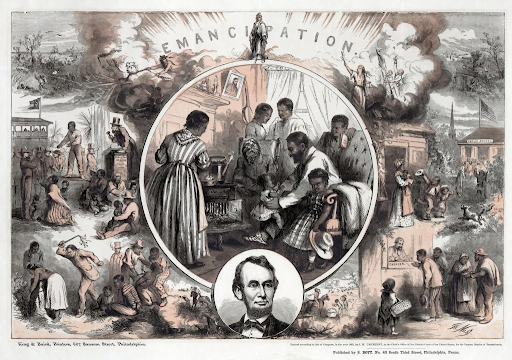by Stephanie Davis
The Emancipation Proclamation is widely known as the document that declared enslaved people free. Issued by President Abraham Lincoln on September 22, 1862, the Proclamation declared that “all persons held as slaves within any State or designated part of a State, the people whereof shall then be in rebellion against the United States, shall be then, thenceforward, and forever free.” However, it was preliminary in nature, meant to persuade the Confederate states to surrender and therefore end the Civil War. While the document served as a foundation for future legislation, it was itself limited in scope. The Proclamation only applied to Southern states in conflict with the Union. It also exempted some Confederate states, including Tennessee.
When the Confederates did not stand down, the Proclamation went into full effect on January 1, 1863. As the War continued, whenever Union soldiers gained control of a region, enslaved people were informed of their freedom and the Proclamation was enforced. This meant that emancipation was observed on different days depending on the progression of the War.
Tennessee’s case was unique in that the State’s recognition of emancipation, because of its exception, was not directly dependent on Union victory. Emancipation Day in the state took shape in a different way.
The History of Emancipation Day in 1796: A Journal of Tennessee History – Tennessee Historical Society
Andrew Johnson, Tennessee’s military governor at the time, and later the 17th president of the United States, successfully persuaded Lincoln to exclude Tennessee from the consequences of the Proclamation. This meant that enslaved Tennesseans did not join people in states such as Alabama, Florida, Georgia, and Mississippi in celebrating Emancipation Day on January 1. Seven months after the Proclamation’s implementation, on August 8, 1863, when Andrew Johnson freed his personal slaves at his home in Greeneville, Tennessee, emancipation was finally acknowledged in East Tennessee. August 8 became Emancipation Day, also known as Freedom Day, and was celebrated in Greeneville. Sam Johnson, a man formerly enslaved by Andrew Johnson, was instrumental in having the date observed and celebrated.
Sam Johnson, Courtesy of the Andrew Johnson National Historic Site, National Park Service
Freed slaves from Jefferson Davis’s Brierfield Plantation reaching Union lines, June 1863. (Artist’s impression).
In 1871, Sam Johnson organized the first recorded celebration of Emancipation Day, held in Greeneville. According to the Knoxville Chronicle, a procession was held with Sam Johnson as the officer of the day. He was followed by a band and the citizens of Greeneville. The celebration included an address by then-former president Andrew Johnson and a picnic. A tradition began that day. Every year on August 8, African American residents put on their finest clothes, prepared their best dishes, and met their friends and families for a day of festivities. People would travel from across Tennessee to celebrate in Greeneville. In 1888, it was reported that about 200 people traveled from Knoxville to Greeneville.
Knoxville Chronicle’s coverage of celebration, courtesy of National Park Service
Eventually, the celebration spread to other Tennessee cities. In 1897, an estimated 500 people visited Johnson City from Knoxville. In 1900, “3500 people from Birmingham, Asheville, Bristol and other cities came to Knoxville for the August 8 celebration,” as mentioned on the Beck Cultural Exchange Center’s website. Like Greeneville, Knoxville became a central location for the August 8 celebration. People gathered at Chilhowee Park for dances, games, and performances by musicians like Louis Armstrong. During segregation, August 8 was the only day African Americans were allowed in Chilhowee Park. Emancipation Day celebrations also occurred in Clarksville, Nashville, and Memphis, with thousands in attendance. Sam Johnson’s efforts led to a growing tradition of August 8 being observed as Emancipation Day in Tennessee. He expanded his work by becoming a commissioner for the Bureau of Refugees, Freedmen, and Abandoned Lands, or the Freedmen’s Bureau, a federal agency developed by President Lincoln to help the newly-freed.
August 8 has since been celebrated in Tennessee and surrounding states like Kentucky, Missouri, and Virginia for over 150 years. There had been a decline its significance with the rise of Juneteenth as the nationwide Emancipation Day holiday, but a recent resurgence has seen August 8 celebrations continue. The Beck Cultural Exchange Center in Knoxville hosts an annual “Eighth of August Jubilee” and Greeneville, where it all began, has an annual “Eighth of August Freedom Day” celebration. African American Clarksville residents have continued to honor the day with events as well. In keeping with the tradition of earlier celebrations, August 8 gatherings usually feature concerts, games, parades, speeches, and other activities.
Recent legislation has also contributed to the date’s significance. House Bill No. 207 was signed in 2007 by former Governor of Tennessee, Phil Bredesen, acknowledging August 8 as “Emancipation Day.” More recently, Tennessee State Representative Rick Staples proposed a bill to have Emancipation Day designated as a legal state holiday. On March 2, 2020, the bill passed the House unanimously. It is awaiting further action in the Senate. Last year on August 8, Governor Bill Lee proclaimed the date as Emancipation Day. Governor Lee said that Johnson’s act of freeing his slaves sparked “celebrations of freedom that continue to this day throughout Tennessee.” Throughout Tennessee, communities continue to honor August 8, confirming the date as a significant time in Tennessee and African American history that symbolized movement toward freedom.
Slavery officially ended in Tennessee when voters ratified an amendment to the State’s constitution on February 22, 1865, about a month after Congress passed the 13th Amendment, which abolished slavery in the United States.
Stephanie Davis is a Tennessee State Museum Community Engagement Educator.

